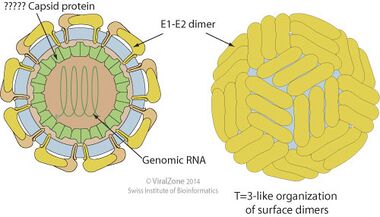Biology:Pegivirus
| Pegivirus | |
|---|---|
| Virus classification | |
| (unranked): | Virus |
| Realm: | Riboviria |
| Kingdom: | Orthornavirae |
| Phylum: | Kitrinoviricota |
| Class: | Flasuviricetes |
| Order: | Amarillovirales |
| Family: | Flaviviridae |
| Genus: | Pegivirus |
| Species | |
|
Pegivirus A | |
Pegivirus is the approved name for a genus of single positive-stranded RNA viruses in the family Flaviviridae.[1][2][3][4] The name is a derived one: "Pe" stands for "persistent" and "g" is a reference to Hepatitis G, a former name of the C species.

Taxonomy
Eleven named species are within the genus Pegivirus.[2] Isolates belonging to the species Pegivirus C are monophyletic and show < 50% nucleotide (55% amino acid) sequence divergence between aligned sequences from the polyprotein from each other. However, all differ by >50% nucleotide (>55% amino acid) divergence from other members of this genus. Pegiviruses assigned to this species (Pegivirus A) originate from primate host species (humans, chimpanzees and several New World monkey species). The sequence U22303 has been assigned as the type member of the species, as this was the first pegivirus to be described for this species. Terminology to describe viruses with different hosts has not been approved by the International Committee on Taxonomy of Viruses; however, Pegivirus A viruses have been called HPgV for human pegivirus, SPgV for new world simian pegiviruses, and SPgVcpz for chimpanzee simian virus.[citation needed]
A second species within the pegiviruses is termed Pegivirus B. Only one virus was included in the naming proposal, which was a complete genome of a virus found in the bat species Pteropus giganteus. This sequence differs by >50% nucleotide (>55% amino acid) divergence from all proposed members of the primate-derived Pegivirus C species that originate from primate host species (humans, chimpanzees, and several New World monkey species). The sequence GU566734 has been assigned as the type member of the species, as this was the first pegivirus to be described for this species.[citation needed]
The use of deep sequencing technologies has identified additional viruses that differ from Pegivirus B species by >50% nucleotide (>55% amino acid) and Pegivirus C in rodents, horses, and in different bat species, and Old World monkeys and the number of Pegivirus species has been expanded to eleven.[5]
Revised taxonomy
The species known in 2016 have since then been classified into 11 species—Pegivirus A–K.[2][5]
- Pegivirus A includes the virus GBV-A
- Pegivirus B includes the virus GBV-D
- Pegivirus C includes the virus GBV-C
- Pegivirus D includes the virus Theiler’s disease-associated virus
- Pegivirus E includes the virus Equine pegivirus
- Pegivirus F includes the virus Bat pegivirus
- Pegivirus G includes the virus Bat pegivirus
- Pegivirus H includes the virus Human pegivirus 2
- Pegivirus I includes the virus Bat pegivirus
- Pegivirus J includes the virus Rodent pegivirus
- Pegivirus K includes the virus Porcine pegivirus
History
- In 1967, experimental inoculation of serum from a thirty four year old surgeon (George Barker) with acute hepatitis into tamarins was reported to have resulted in hepatitis.[6]
- In 1995, two new members of the family Flaviviridae (GBV-A and GBV-B) were identified in tamarins that developed hepatitis following inoculation with the 11th GB passage. A number of GBV-A variants were later identified in wild New World monkeys that were captured.
- Subsequently in 1995, a human virus was identified [GBV-C or hepatitis G virus (HGV)].
- A more distantly related virus (GBV-D) was later discovered in the bat (Pteropus giganteus).[7]
- The genus Pegivirus was proposed in 2011.[3] GBV-B was assigned to the genus Hepacivirus,[2] whereas GBV-A together with GBV-C were assigned to the new genus Pegivirus.[2]
- In 2016 the Pegivirus genus was divided into 11 species – pegiviruses A–K with GBV-C classified under pegivirus C species.[5]
Notes
- Theiler's disease — a form of equine hepatitis — also appears to be caused by a pegivirus—Theiler disease–associated virus.[8]
- Human hepegivirus 1 or Human Pegivirus 2 (HPgV2) is a virus isolated from 2 multiply transfused hemophiliacs and two transfused patients.[9] This virus appears to belong to a new clade in the Pegiviruses.
- A related virus has been isolated from the graceful catshark (Proscyllium habereri).[10]
- The human pegiviruses appear to be related to the nonhuman primate species.[11]
- Researchers in 2019 described Human pegivirus-1 as a "cause of human encephalitis (Leukoencephalitis)"; as well as sexually and mother-to-child transmissible.[12]
- Another virus—rodent pegavirus—has been isolated from the white throated woodrat (Neotoma albigula).[13]
- A pegivirus (equine pegivirus) has also been isolated from a horse.[14]
References
- ↑ Simmonds, Peter; Becher, Paul; Bukh, Jens; Gould, Ernest A; Meyers, Gregor; Monath, Tom; Muerhoff, Scott; Pletnev, Alexander et al. (2017). "ICTV Virus Taxonomy Profile: Flaviviridae". Journal of General Virology 98 (1): 2–3. doi:10.1099/jgv.0.000672. PMID 28218572.
- ↑ 2.0 2.1 2.2 2.3 2.4 "ICTV Report Flaviviridae". http://www.ictv.global/report/flaviviridae.
- ↑ 3.0 3.1 Stapleton, J. T; Foung, S; Muerhoff, A. S; Bukh, J; Simmonds, P (2010). "The GB viruses: A review and proposed classification of GBV-A, GBV-C (HGV), and GBV-D in genus Pegivirus within the family Flaviviridae". Journal of General Virology 92 (2): 233–46. doi:10.1099/vir.0.027490-0. PMID 21084497.
- ↑ Adams, M. J; Lefkowitz, E. J; King, A. M. Q; Carstens, E. B (2013). "Recently agreed changes to the International Code of Virus Classification and Nomenclature". Archives of Virology 158 (12): 2633–9. doi:10.1007/s00705-013-1749-9. PMID 23836393.
- ↑ 5.0 5.1 5.2 Smith, Donald B; Becher, Paul; Bukh, Jens; Gould, Ernest A; Meyers, Gregor; Monath, Thomas; Muerhoff, A. Scott; Pletnev, Alexander et al. (2016). "Proposed update to the taxonomy of the genera Hepacivirus and Pegivirus within the family Flaviviridae". Journal of General Virology 97 (11): 2894–2907. doi:10.1099/jgv.0.000612. PMID 27692039.
- ↑ Deinhardt F, Holmes AW, Capps RB, Popper H (1967) Studies on the transmission of human viral hepatitis to marmoset monkeys. I. Transmission of disease, serial passages, and description of liver lesions. J Exp Med 125 (4) 673-688
- ↑ Epstein, Jonathan H; Quan, Phenix-Lan; Briese, Thomas; Street, Craig; Jabado, Omar; Conlan, Sean; Ali Khan, Shahneaz; Verdugo, Dawn et al. (2010). "Identification of GBV-D, a Novel GB-like Flavivirus from Old World Frugivorous Bats (Pteropus giganteus) in Bangladesh". PLOS Pathogens 6 (7): e1000972. doi:10.1371/journal.ppat.1000972. PMID 20617167.
- ↑ Chandriani, S; Skewes-Cox, P; Zhong, W; Ganem, D. E; Divers, T. J; Van Blaricum, A. J; Tennant, B. C; Kistler, A. L (2013). "Identification of a previously undescribed divergent virus from the Flaviviridae in an outbreak of equine serum hepatitis". Proceedings of the National Academy of Sciences 110 (15): E1407–15. doi:10.1073/pnas.1219217110. PMID 23509292. Bibcode: 2013PNAS..110E1407C.
- ↑ Kapoor, Amit; Kumar, Arvind; Simmonds, Peter; Bhuva, Nishit; Singh Chauhan, Lokendra; Lee, Bohyun; Sall, Amadou Alpha; Jin, Zhezhen et al. (2015). "Virome Analysis of Transfusion Recipients Reveals a Novel Human Virus That Shares Genomic Features with Hepaciviruses and Pegiviruses". mBio 6 (5): e01466–15. doi:10.1128/mBio.01466-15. PMID 26396247.
- ↑ Shi, Mang; Lin, Xian-Dan; Vasilakis, Nikos; Tian, Jun-Hua; Li, Ci-Xiu; Chen, Liang-Jun; Eastwood, Gillian; Diao, Xiu-Nian et al. (2016). "Divergent Viruses Discovered in Arthropods and Vertebrates Revise the Evolutionary History of the Flaviviridae and Related Viruses". Journal of Virology 90 (2): 659–69. doi:10.1128/JVI.02036-15. PMID 26491167.
- ↑ Thézé, Julien; Lowes, Sophia; Parker, Joe; Pybus, Oliver G (2015). "Evolutionary and Phylogenetic Analysis of the Hepaciviruses and Pegiviruses". Genome Biology and Evolution 7 (11): 2996–3008. doi:10.1093/gbe/evv202. PMID 26494702.
- ↑ "Scientists discover a hidden cause of encephalitis". https://medicalxpress.com/news/2019-02-scientists-hidden-encephalitis.html.
- ↑ Kapoor, A; Simmonds, P; Scheel, T. K. H; Hjelle, B; Cullen, J. M; Burbelo, P. D; Chauhan, L. V; Duraisamy, R et al. (2013). "Identification of Rodent Homologs of Hepatitis C Virus and Pegiviruses". mBio 4 (2): e00216–13. doi:10.1128/mBio.00216-13. PMID 23572554.
- ↑ Kapoor, A; Simmonds, P; Cullen, J. M; Scheel, T. K. H; Medina, J. L; Giannitti, F; Nishiuchi, E; Brock, K. V et al. (2013). "Identification of a Pegivirus (GB Virus-Like Virus) That Infects Horses". Journal of Virology 87 (12): 7185–90. doi:10.1128/JVI.00324-13. PMID 23596285.
Wikidata ☰ Q16917856 entry
 |


